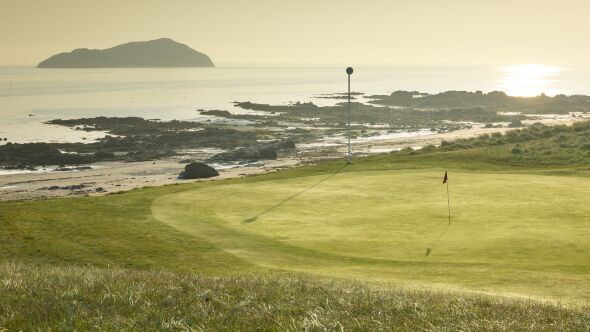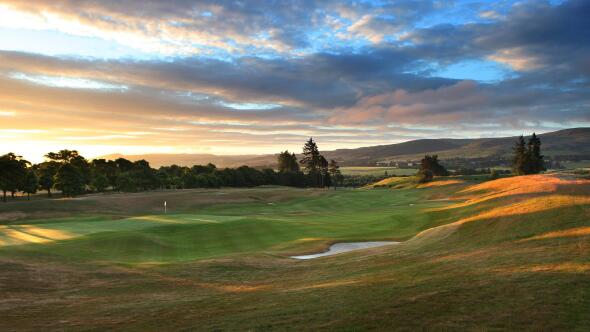Dunbar Golf Club

About
Get a taste of history at Dunbar Golf Club, where the traditional links have been battled since 1856. Dunbar makes a good destination for a day devoted to golf, with a clubhouse, restaurant, practice facilities and pro shop. On a take-your-breath-away landscape, take on a course where all of the major Scottish Championships have been played.
The par-71, 6,597-yard golf course offers three par 5s, including the monster 506-yard ninth hole, Longbanks. Year-round, these North Sea links offer the total golf experience on this narrow strip that runs along a rocky beach, bordered by the Old Deer Park wall. Battling the sea wind to hit the well defined holes following the coastal contours guaranteed a new experience every round. Light breezes transform the course into a serious challenge.
Dunbar Golf Club management suggests a visit to the clubhouse afterward: "The malt selection is almost as daunting as the doglegging 382-yard seventh hole."
| Tee | Par | Length | Rating | Slope |
|---|---|---|---|---|
| White | 71 | 6597 yards | 72.3 | 128 |
| White (W) | 72 | 6597 yards | 77.7 | 135 |
| Yellow | 71 | 6196 yards | 70.4 | 124 |
| Yellow (W) | 72 | 6196 yards | 75.5 | 131 |
| Red (W) | 72 | 5696 yards | 72.7 | 126 |
| Red | 71 | 5696 yards | 68.2 | 120 |
| Hole | 1 | 2 | 3 | 4 | 5 | 6 | 7 | 8 | 9 | Out | 10 | 11 | 12 | 13 | 14 | 15 | 16 | 17 | 18 | In | Total |
|---|---|---|---|---|---|---|---|---|---|---|---|---|---|---|---|---|---|---|---|---|---|
| White Long M: 72.3/128 W: 77.7/135 | 474 | 541 | 173 | 353 | 147 | 386 | 382 | 370 | 532 | 3358 | 202 | 460 | 457 | 377 | 432 | 338 | 163 | 375 | 435 | 3239 | 6597 |
| White Short M: 71.0/126 W: 76.4/133 | 474 | 541 | 173 | 353 | 147 | 386 | 382 | 370 | 532 | 3358 | 202 | 460 | 457 | 377 | 432 | 338 | 163 | 338 | 435 | 3202 | 6560 |
| Yellow M: 70.4/124 W: 75.5/131 | 460 | 490 | 152 | 340 | 162 | 347 | 371 | 323 | 506 | 3151 | 202 | 418 | 445 | 359 | 413 | 322 | 145 | 320 | 421 | 3045 | 6196 |
| Red M: 68.2/120 W: 72.7/126 | 448 | 448 | 150 | 308 | 133 | 315 | 360 | 312 | 465 | 2939 | 182 | 359 | 389 | 339 | 404 | 303 | 138 | 284 | 359 | 2757 | 5696 |
| Handicap | 9 | 3 | 15 | 5 | 17 | 1 | 13 | 11 | 7 | 12 | 8 | 2 | 14 | 4 | 18 | 16 | 6 | 10 | |||
| Par | 5 | 5 | 3 | 4 | 3 | 4 | 4 | 4 | 5 | 37 | 3 | 4 | 4 | 4 | 4 | 4 | 3 | 4 | 4 | 34 | 71 |
| Handicap (W) | 11 | 3 | 15 | 7 | 17 | 1 | 5 | 13 | 9 | 12 | 8 | 2 | 4 | 16 | 6 | 18 | 14 | 10 |
Course Details
Rentals/Services
Practice/Instruction
Policies
Food & Beverage
RestaurantAvailable Facilities
Clubhouse, Internet AccessReviews
Reviewer Photos
A Classic Links Course
This is a great Old School Links Course. It is a little under the radar when compared to Muirfiled or North Berwick, but a fantastic golf course. This was the course that the "locals" play instead of the big name ones on the golf tours. The setting is amazing as it works its way down the coast. The wind WILL be a factor here. I live in California and never have to deal with significant wind on a course. I was in for a real wake up here ! I found that half the fun was planning my strategy and using different clubs on the same distance depending on the wind direction. There are spectacular views on this course. Bring your camera in your golf bag, you will want to take pictures to put on your wall back home.
Hidden Gem
Definitely a hidden gem. Gets lost in the shuffle because it is near higher profile courses such as Muirfield, Gullane and North Berwick. It should be a must-play if you are in East Lothian area. Tremendous setting and plenty of holes near or on the water. Course is challenging, but won't punish you. Can play the entire round with one ball.
Lothians' not-so-hidden Gem
If you are in the East Lothians area, you will want to play Muirfield (Plan a year ahead) and North Berwick West Links. If you are going to spend a handful of days in one area, something I would advise so your trip isn't spent driving, Dunbar Golf Club in Dunbar is about 1/2 hour east of North Berwick and is a fine place to spend a day. I wish that one could give 4 1/2 stars, I reserve 5 for world class time-zone travel worthy courses, for Dunbar would be a fine addition to any East Lothians itinerary.
The staff is very accommodating and nice. In the clubhouse, they treat you like a member. Enjoy lunch between 18s or have a dram or pint. Watched some Wimbledon with members. The proshop staff was great and they even snuck me out in front of some members so that I didn't have to wait two hours to go back out for a second 18. On the second 18, caught two members after three holes and joined them. Their knowledge of the course and genuine lack of stuffiness made for a pleasurable second round. The first round was just me on my own, early, and I finished in 3 hours. For a course with famous neighbors, Dunbar did have their late morning tee times stacked, but we still finished the second 18 in 4:00 not a 5 hour slogfest like back in the States. At about $140 for a day ticket, this is another great Links Value.
The course itself is proper links golf. The fairways are firm and fast. The bunkering is not overdone, but enough of them to make for a proper line on your drive or approach. Two holes have burns so you shouldn't go through multiple sleeves of balls and if on your game, you won't lose one ball. Of course, there are bump and run, playing the contours and other things that make links golf "Pleasurable Excitement". The first three holes are a par 4, 5 and 3 which are near the clubhouse. The next 14 holes take place near the water; there is an old stone wall that separates the two areas which just lends to the charm. The 18th plays back to the clubhouse on the same side of the wall as the first three. Although there really aren't any holes which stand out, especially in this region, there isn't a weak hole and a few that might stand out in a less prestigious neighborhood. Only one blind approach and that is at the 7th hole. The rest is pretty straight-forward and a lot of fun.
All in all, after getting on to Muirfield #Lucky you# and playing North Berwick #my favorite in the area# Dunbar should be up there with Gullane as a course to fill out an East Lothians' trip or part of a larger trip to Scotland.






























